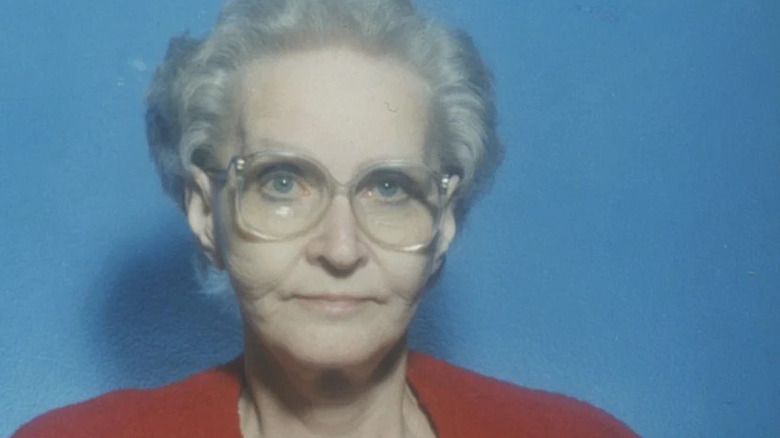What Happened To Dorothea Puente's Victim Alvaro 'Bert' Montoya?
Considering the typical criminal profile associated with serial killers — white males, in their 30s or 40s, so on, and so forth — there may not be a serial killer who fits that prototype less than Dorothea Puente.
Puente looked more like your run-of-the-mill grandmother than a vicious serial killer, and according to The New York Post, she even told people they could call her "Grandma." Puente ran a boarding house in Sacramento, California, and while boarders had hoped they were getting an affordable place to stay, in reality, they were getting a one-way ticket to a hole in Puente's backyard.
The little old landlady was convicted of killing a total of nine people. Her victims were often people with disabilities or were down on their luck, people whose disappearances were likely to go relatively unnoticed, until a social worker reported one of her clients, Alvaro "Bert" Montoya, missing — which led to the revelation of Puente's heinous crimes.
Who was Dorothea Puente?
According to Sactown Magazine, Dorothea Puente was born in Redlands, California in 1929. She was the sixth of seven children and had a childhood that was anything but easy. Her family was poor and when she was just 8 years old, her father died of tuberculosis, which left her with her alcoholic mother who ultimately lost custody in 1938 — and was killed in a motorcycle accident just a few years later. Dorothea then lived with relatives through her early teenage years.
At 16 she moved to Olympia, Washington, and worked as a sex worker. Some years later, after her first marriage — one of several — fell apart, Puente was arrested for trying to pass a check under a fake name. She reportedly spent time in a psychiatric ward in the early 1960s, at which point doctors placed her on antipsychotic medications.
Puente also claimed to be friends with prominent California politicians like Governor Jerry Brown and President Ronald Reagan. There is, however, little evidence to back up her having any relationship with these politicians outside of quick photo ops at charity events.
Dorothea Puente's first victims
According to Screenrant, Ruth Monroe moved into Dorothea Puente's boarding house in 1982. It seemed like a great fit; the two women were best friends and Monroe needed a support system after her husband became terminally ill. However, just three weeks after moving into the house, Monroe was found dead. Toxicology tests determined that she had died from an overdose of codeine and Tylenol. Investigators spoke with Puente, who told them that Monroe was seriously depressed given her husband's health situation. It was a relatively believable story, at least enough for police to buy it, and Monroe's death was ruled a suicide.
Just a few weeks after Monroe's death, a 74-year-old man accused Puente of drugging him and stealing money, a foreshadowing of Puente's later, often financially motivated crimes. She was convicted and sentenced to five years in jail, though she'd get out in 1985 (via Crime Museum). In prison, she started exchanging letters with a 77-year-old man named Everson Gillmouth. Once out of prison, Puente and Gillmouth opened a joint bank account. That same year, Puente gave a red truck — which had belonged to Gillmouth — to a man who had completed work on her house. She had that same worker build a box that was eventually discovered by a fisherman in early 1986. Inside it was the body of an elderly man, later identified as Everson Gillmouth.
Who was Alvaro "Bert" Montoya?
According to Find A Grave, Alvaro "Bert" Montoya was born in Costa Rica on September 8, 1936. Sactown Magazine described him as "a gentle bear of a man," but life was by no means easy for him. Montoya spent years living on the streets and in shelters, due in large part to untreated mental disorders including schizophrenia.
According to Screenrant, Montoya was 51 years old when he crossed paths with Puente. Her boarding house had garnered a reputation as a great place for the elderly, disabled, or those battling addiction to live while they got back on their feet. Social workers even referred clients to Puente's boarding house, unknowingly sending them into the clutches of a killer. Montoya was one of those people who was referred to the Puente-run boarding house at 1426 F Street in Sacramento by his social worker. That same social worker would be the one to notice that there was something nefarious happening down at the little old lady's boarding house.
Montoya goes missing
The key to Puente's murders staying under the radar for as long as they did, was that most of her victims were people that were unlikely to be reported missing. Montoya was one of those people, with Sactown Magazine describing him as a "transient." So, it's fitting she was undone by a social worker who noticed she hadn't heard from one of her clients.
Judy Moises was the social worker who placed Montoya in Puente's boarding house and had even met with the owner/proprietor/murderer beforehand. So, upon learning that Montoya had apparently left the boarding house without her knowledge, Moises was understandably suspicious. She went to speak with Puente who gave conflicting explanations for where Montoya was, saying at different times that he had gone to Mexico and Utah. Moises didn't buy it and she filed a missing person report on November 7, 1988.
A police officer was sent to the boarding house where he interviewed Puente and John Sharp. Sharp was a tenant at the boarding house and he backed up Puente's story about Montoya's whereabouts. However as the officer was leaving, Sharp slipped him a note that said Puente had forced him to lie.
Police eventually searched the backyard of the house where they discovered seven bodies, each one containing the drug Dalmane, which is used to treat insomnia, according to The New York Post. It was reported that Puente had drugged or strangled her victims, before cashing their social security checks.
Puente goes gets convicted
After briefly fleeing down south to Los Angeles because there hadn't yet been enough evidence against her for an arrest, Puente was flown back to Sacramento and charged with nine murders (via The New York Post). On the way there, she reportedly told investigators "I used to be a very good person at one time."
Police were able to connect Puente to the victims found in her backyard, as well as the suspicious deaths of two people she was close to: Ruth Monroe and Everson Gillmouth.
In 1993, Puente was convicted of three murders for which she received a pair of life sentences (via Crime Museum). Prosecutors described her as one of the most "cold and calculating female killers the country had ever seen." In 2011, Puente died in prison at the age of 82. She reportedly maintained her innocence the entire time she was in prison and claimed that all of her alleged victims had died of natural causes.





